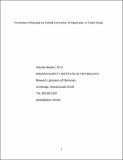Prevention of myopia by partial correction of hyperopia: a twins study
Author(s)
Medina, Alan
Download10792_2017_493_ReferencePDF.pdf (248.8Kb)
PUBLISHER_POLICY
Publisher Policy
Article is made available in accordance with the publisher's policy and may be subject to US copyright law. Please refer to the publisher's site for terms of use.
Terms of use
Metadata
Show full item recordAbstract
Purpose To confirm the prediction of emmetropization feedback theory that myopia can be prevented by correcting the hyperopia of a child at risk of becoming myopic. Methods We conducted such myopia prevention treatment with twins at risk. Their hyperopia was partially corrected by one half at age 7 and in subsequent years until age 16. Results Hyperopia progressively decreased in all eyes as expected. None of the twins developed myopia. The spherical equivalent refractions of the followed eyes were +1 and +1.25 D at age 16. Feedback theory accurately predicted these values. Conclusions The treatment of the twins with partial correction of their hyperopia was successful. Prevention of myopia with this technique is relatively simple and powerful. The use of this myopia prevention treatment has no adverse effects. This prevention treatment is indicated in children with a hyperopic reserve at risk of developing myopia.
Date issued
2017-03Department
Massachusetts Institute of Technology. Department of Electrical Engineering and Computer Science; Massachusetts Institute of Technology. Research Laboratory of ElectronicsJournal
International Ophthalmology
Publisher
Springer Netherlands
Citation
Medina, Antonio. “Prevention of Myopia by Partial Correction of Hyperopia: a Twins Study.” International Ophthalmology 38, no. 2 (March 10, 2017): 577–583.
Version: Author's final manuscript
ISSN
0165-5701
1573-2630